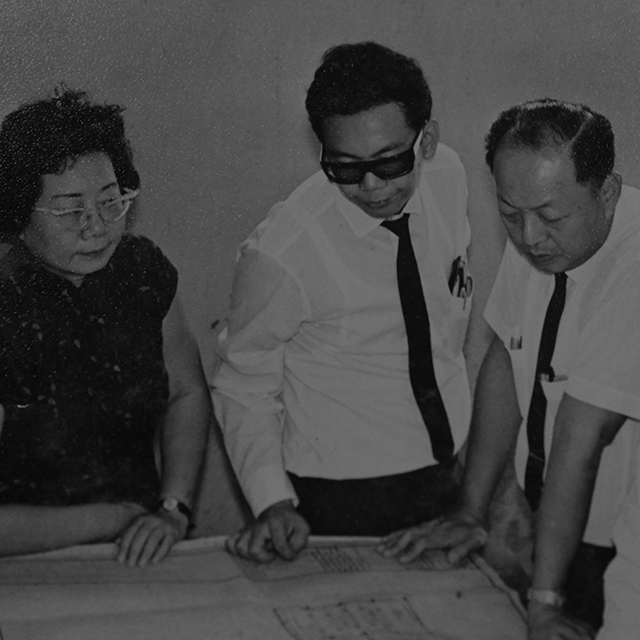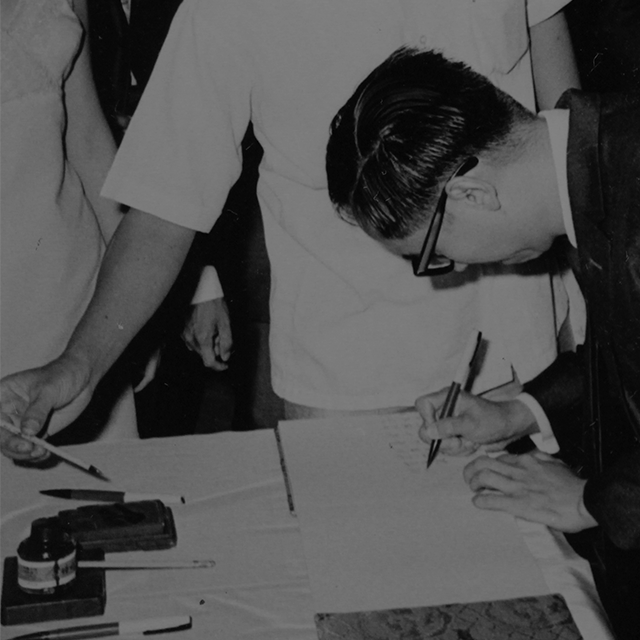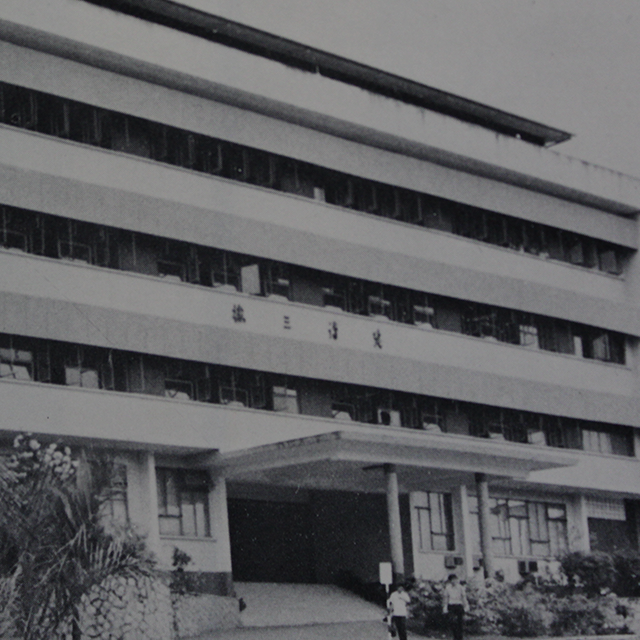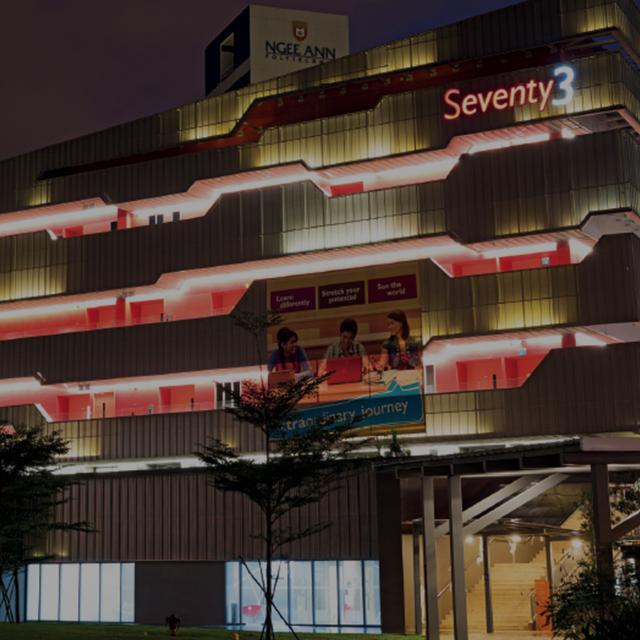History & Milestones
The history of Ngee Ann Polytechnic can be traced back to 1963, when it started out as Ngee Ann College. Its founder, The Ngee Ann Kongsi, had envisioned setting up a quality educational institution to link the Chinese-speaking community to its cultural roots during the colonial-rule era. The College had since morphed into a full-fledged polytechnic, a public institution overseen by an independent Council.
Six decades on, the Polytechnic has become a leading institution of higher learning, anchored on its core strengths of pioneering a broad-based and holistic learning approach, forging strategic alliances and providing enriching overseas experiences to prepare its students for a global workplace. The transformation of Ngee Ann Polytechnic has been a spectacular one, as evident in the key milestones recorded here.





1960s - Founding Years
Ngee Ann College was inaugurated on May 25, 1963.
The College became a legal independent institution governed by a Council,
To reflect its expanded role and focus on technical education, the College changed its name to Ngee Ann Technical College.
To reflect its expanded role and focus on technical education, the College changed its name to Ngee Ann Technical College.
The College moved from the Teochew Building at Tank Road to its Clementi campus.
1970s - Changing Focus
The degree courses were phased out.
English replaced Chinese as the College’s sole medium of instruction.
The Business Orientation Programme was introduced
1980s – From College to Polytechnic
In 1981, a five-year Phase I campus expansion project was launched to cater to an accelerated increase in student enrolment.
In 1981, a five-year Phase I campus expansion project was launched to cater to an accelerated increase in student enrolment. Completed in 1986, the first phase covered construction of new buildings including laboratories, lecture theatres, four canteens, a sports complex, three residential apartment blocks and an eight-story administration building.
To reflect its expanded role in providing quality education, the college’s name was changed to Ngee Ann Polytechnic (Ngee Ann).
To reflect its expanded role in providing quality education, the college’s name was changed to Ngee Ann Polytechnic (Ngee Ann). Course curricula were also revised to promote practical and hands-on training.
The Continuing Education Centre (currently known as CET Academy)
The Continuing Education Centre (currently known as CET Academy) was set up to provide a platform for postgraduates and working professionals to further their education and upgrade their skills.
NP embarked on Phase II campus expansion that added new facilities such as teaching blocks.
NP embarked on Phase II campus expansion that added new facilities such as teaching blocks. Two subsequent phases were rolled out in 1990 and 1992.
NP celebrated its 25th anniversary. By then, its enrolment surpassed the 10,000-mark.
NP celebrated its 25th anniversary. By then, its enrolment surpassed the 10,000-mark. The late president Mr Ong Teng Cheong planted a Tembusu tree to mark the occasion. Celebrations culminated in the planting of a time capsule by Dr Tay Eng Soon that was unearthed in 2013.
1990s – Pioneered E-Learning
NP's Human Resource Office started the International Fellowship and Visiting Lecturer Scheme,
NP's Human Resource Office started the International Fellowship and Visiting Lecturer Scheme, a move that attracted lecturers from UK, US, Australia, Japan, New South Wales, China and India.
The Polytechnic rolled out a new phase of campus environment and facilities upgrading.
The Polytechnic rolled out a new phase of campus environment and facilities upgrading. Known as the Phase 1 campus redevelopment programme, the Polytechnic's Multi-Purpose Hall underwent major refurbishment works.
The Polytechnic was the first of its kind to launch Mobile e-Learning,
The Polytechnic was the first of its kind to launch Mobile e-Learning, which encompassed a notebook ownership scheme, a wireless campus network and an e-learning platform.
NP was accorded the prestigious Singapore Quality Class Award.
2000s – Rapid Growth
The Polytechnic launched the Ngee Ann Learning Model (NLM), its unique broad-based approach of equipping students with a judicious blend of hard and soft skills to thrive in the knowledge economy.
The Polytechnic launched the Ngee Ann Learning Model (NLM), its unique broad-based approach of equipping students with a judicious blend of hard and soft skills to thrive in the knowledge economy.
In the same year, NP pioneered a talent development programme to prepare high calibre students for their career and future studies.
The Polytechnic also unveiled the Lifestyle Library, the first library in a tertiary institution to provide a relaxing environment, with non-academic books, magazines, cable TV, Internet access, CDs and DVDs for the enjoyment of our students.
NP rolled out its plan to incorporate interdisciplinary studies into the curriculum.
NP rolled out its plan to incorporate interdisciplinary studies into the curriculum.
As part of NP’s Phase 5 redevelopment plan, an expansive two-level 1,800-seat Convention Centre that also houses four lecture theatres was built to replace The Octagon.
The Office for Innovation and Enterprise (IE) (initially called Innohub) was formed to offer industry partners consultancy services and showcase the Polytechnic’s technological expertise. It launched the EnterpriZe! Scheme to help enterprising students commercialise their products and business ideas.
Important strides were made overseas as the Polytechnic collaborated with Zhejiang University City College to provide Diploma in Chinese Studies students with the chance to go on a China immersion programme.
Important strides were made overseas as the Polytechnic collaborated with Zhejiang University City College to provide Diploma in Chinese Studies students with the chance to go on a China immersion programme.
The School of Engineering also launched the Common First Year Pathway Programme (now known as the Common Engineering Programme) that allows new students to choose their Engineering discipline after a semester of taking common engineering modules.
NP and SPRING Singapore jointly established the Marine & Offshore Technology Centre of Innovation (MOT COI) at the Polytechnic.
NP and SPRING Singapore jointly established the Marine & Offshore Technology Centre of Innovation (MOT COI) at the Polytechnic. MOT COI served as a one-stop centre to catalyse the growth of the marine industry by helping SMEs in the industry with technology innovation.
Under the Ministry of Education’s Polytechnic-Foreign Specialised Institute (Poly-FSI) scheme,
Under the Ministry of Education’s Polytechnic-Foreign Specialised Institute (Poly-FSI) scheme, NP was the first to strike a degree tie-up with renowned Boston's Wheelock College to offer NP graduates the opportunity to pursue a Bachelor of Science in Early Childhood Educational Studies and Leadership at the Polytechnic’s premises.
NP launched a $1 million Solar Technology Centre. Partly funded by the Economic Development Board, the Centre serves as a hotbed for applied research and student projects on solar technology.
NP launched a $1 million Solar Technology Centre. Partly funded by the Economic Development Board, the Centre serves as a hotbed for applied research and student projects on solar technology.
A $7.6 million Environmental and Water Technology Centre of Innovation officially opened in July. The applied research facility helps small and medium enterprises develop commercially-viable products and solutions in the areas of water and wastewater treatment and management, waste management, pollution control, and clean energy.
NP was picked to play a key role in the setting up of the School of Science and Technology (SST) which would tap the Polytechnic’s expertise and resources in applied learning for the design and planning of its curriculum, pedagogy and campus development. SST is Singapore’s fourth specialised independent school under the Ministry of Education’s landmark initiative to inject greater choice and diversity into the secondary school education landscape.
In November, NP signed a Memorandum of Understanding with the Singapore Media Academy and the Workforce Development Agency to jointly set up Singapore’s first Media CET Centre to train media professionals. The Media CET Centre is part of a $40 million government initiative to boost the media industry.
NP’s talent development programme was revamped and renamed The Christieara Programme (TCP) to boost the Polytechnic’s efforts in nurturing high calibre students. A new feature of TCP was the California Challenge, a three-week study trip with a liberal arts focus.
NP’s talent development programme was revamped and renamed The Christieara Programme (TCP) to boost the Polytechnic’s efforts in nurturing high calibre students. A new feature of TCP was the California Challenge, a three-week study trip with a liberal arts focus.
One of NP’s landmarks, the Teo Hang Sam Building – which was the first building erected on its Clementi campus in 1966 – and the adjourning Canteen One were demolished to make way for the new block Seventy3. It marked the onset of Phase 6 of the campus redevelopment programme.
The School of Film & Media Studies (FMS) officially launched m:idea, the first media conglomerate operated by an educational institution in Singapore. Through m:idea, FMS students pitched for businesses and undertook commercial projects by offering a full suite of media services including editorial management, video production and events planning.
2010s – Future-Ready
The Polytechnic officially launched Dialogue in the Dark Singapore, a walking tour of simulated environments in complete darkness, led by visually impaired guides.
The Polytechnic officially launched Dialogue in the Dark Singapore, a walking tour of simulated environments in complete darkness, led by visually impaired guides. Founded by renowned German social entrepreneur Dr Andreas Heinecke, Dialogue in the Dark has been introduced in over 30 countries. The one located at NP was the first in the world to be set up in an educational institution to give students hands-on experience. Dr Heinecke was present in Singapore for the official opening.
NP opened a $1.2-million Optometry Centre with state-of-the-art facilities to give Diploma in Optometry students ample opportunity for clinical practice. Located at Blk 6, a short walk from the Polytechnic’s main entrance, members of the public are welcome to take advantage of the services offered by the Optometry students.
NP embarked on a strategic affiliation with Nanyang Technological University to reshape the way engineering is taught at the diploma level.
NP students began enjoying new first-rate facilities that support their holistic education, thanks to the new building known as Seventy3,
NP students began enjoying new first-rate facilities that support their holistic education, thanks to the new building known as Seventy3, used as the base for arts and cultural activities. The Sports Complex also underwent a facelift to provide a more dynamic environment for sports. Costing $57 million, the two projects were carried out under the Polytechnic’s Phase 6 campus development programme to enhance facilities for students.
Prime Minister Lee Hsien Loong unveiled a blueprint that set out NP’s 10-year plan to reinvent itself and better prepare students to thrive in the global workplace.
Prime Minister Lee Hsien Loong unveiled a blueprint that set out NP’s 10-year plan to reinvent itself and better prepare students to thrive in the global workplace. Launched at NP’s 50th Anniversary event, the Polytechnic shared its 4th Strategic Plan, which spanned from 2013 to 2022.
In line with the national SkillsFuture movement, to provide greater opportunities for Education and Career Guidance (ECG),
In line with the national SkillsFuture movement, to provide greater opportunities for Education and Career Guidance (ECG), NP initiated a new Industry Mentors’ Network (IMN) programme. This connected first-year polytechnic students to industry professionals to gain access to career advice and industry networking opportunities.
NP became the first polytechnic in Singapore to infuse Service-Learning as a signature pedagogy into its core curriculum across all its diploma programmes.
NP became the first polytechnic in Singapore to infuse Service-Learning as a signature pedagogy into its core curriculum across all its diploma programmes. The new pedagogy fulfilled a two-pronged objective – to align with the Polytechnic’s graduate outcomes to develop students to be passionate learners with a big heart for the community and ready for a global workplace, and to encourage purpose-driven learning to better engage students.
NP partnered with seven industry leaders, Autodesk, Microsoft, Quann, SAP, S3 Innovate, ThoughtWorks and V-Key, to build new smart learning spaces for its School of InfoComm Technology students as part of NP’s Smart Campus initiative to include Technology Enhanced Classrooms, a Security Operations Centre for cyber-security training, a Digital Makers’ Zone for Agile software development and an SAP Next-Gen Lab.
In line with the national push towards becoming a Smart Nation, NP championed embracing technology designed to enrich living and learning on campus.
In line with the national push towards becoming a Smart Nation, NP championed embracing technology designed to enrich living and learning on campus. The Polytechnic started Campus Ecosystem, a programme that aimed to attract 100 start-ups focusing on four areas of innovation – Student Life, Teaching & Learning, Work Culture and Work Processes – to set up business operations within NP.
NP spearheaded the launch of a new joint poly incubator, “Pollinate”, at the JTC Launchpad @ one-north at Block 71 Ayer Rajah Crescent to support entrepreneurship efforts by Polytechnic alumni. It was launched with 14 start-ups with ambitious plans to grow the number to 30 in three years.
Singapore’s Economic Development Board launched the Global Innovation Alliance (GIA) Innovators Academy,
Singapore’s Economic Development Board launched the Global Innovation Alliance (GIA) Innovators Academy, a national programme that aimed to create overseas internship opportunities for students at start-ups or companies undertaking entrepreneurship and innovation. NP is the only polytechnic partner appointed alongside Nanyang Technological University, National University of Singapore and Singapore Management University.
In support of the Smart Nation push to develop deep-tech solutions benefiting Singaporeans, NP jointly developed OpenCerts, the use of blockchain technology for secure and reliable digital certificate verification, in partnership with SkillsFuture Singapore, the Government Technology Agency and the Ministry of Education (MOE).
In support of the Smart Nation push to develop deep-tech solutions benefiting Singaporeans, NP jointly developed OpenCerts, the use of blockchain technology for secure and reliable digital certificate verification, in partnership with SkillsFuture Singapore, the Government Technology Agency and the Ministry of Education (MOE). This initiative marked the first time that blockchain technology was harnessed for use at the national level. It was first piloted in 2018 by GovTech and NP, and the first batch of digital certificates was issued to NP’s graduating cohort.
NP piloted an AI-powered platform for the Early Admissions Exercise (EAE). EVA, the first virtual assistant, was deployed to enhance the polytechnic’s EAE selection process. NP piloted the automation of EAE application write-up reviews and engagement with applicants via an online chat. The polytechnic was excited to demonstrate how deep-tech solutions could be used in an admissions exercise to increase engagement with prospective students and improve administrative efficiency.
NP and UOB jointly launched AGILE, a campus incubator to nurture start-ups, drive student entrepreneurship and encourage ecosystem partnerships.
NP and UOB jointly launched AGILE, a campus incubator to nurture start-ups, drive student entrepreneurship and encourage ecosystem partnerships. The opening ceremony of AGILE – which stands for Accelerating Growth in Innovation, Learning and Entrepreneurship – was officiated by then Minister for Transport Mr Ong Ye Kung, who was also a board member of the Monetary Authority of Singapore.
NP partnered Prudential to train its 1,200 employees to equip them with the skills to better leverage data in their daily work using Artificial Intelligence.
In light of the COVID-19 pandemic, NP announced Career Jumpstart, a graduation support package that provided close to 400 job employment and learning opportunities for the graduating Class of 2020.
As in-person graduation ceremonies across the institutes of higher learning were cancelled due to restrictions imposed during the COVID-19 pandemic, NP initiated virtual festivities in the week of graduation to commemorate the special occasion for the Class of 2020.
The NP Robotics Research & Innovation Centre (RRIC) was launched to co-create customised robotics solutions with industry partners and develop the talent pipeline for the growing sector.
The NP Robotics Research & Innovation Centre (RRIC) was launched to co-create customised robotics solutions with industry partners and develop the talent pipeline for the growing sector. At the event, NP also inked an MOU with SingHealth Polyclinics to develop a disinfection and safe management ambassador robot named HIRO.
NP was the first polytechnic in Singapore to pilot a Personalised Learning Pathway (PLP) programme, giving all full-time diploma students starting their courses in 2020 the chance to graduate with a minor certificate in addition to their diploma. The PLP would become an integral part of NP’s holistic learning model, complementing students’ prescribed core curriculum to future-proof students for the VUCA world.
The first-ever omni-channel Johnson & Johnson Experience Centre (JJEC) equipped with retail technologies such as the POP6 cloud-based point-of-purchase execution solution and a live-streaming set-up, was launched on the NP campus.
The first-ever omni-channel Johnson & Johnson Experience Centre (JJEC) equipped with retail technologies such as the POP6 cloud-based point-of-purchase execution solution and a live-streaming set-up, was launched on the NP campus. The integrated lifestyle store doubling up as a training facility for students from NP’s School of Business & Accountancy was officially opened by Ms Low Yen Ling, Minister of State for Trade & Industry, and Culture, Community & Youth.
NP’s CET Academy (CETA) launched Singapore’s first-ever Human-Centred Design Institute (HCDI) at the inaugural CET Annual. Established in partnership with global training institute LUMA and with the support of SkillsFuture Singapore, the HCDI will offer end-to-end learning and development solutions. The launch was graced by Ms Gan Siow Huang, Minister of State for Education and Manpower.
NP launched the NP x Carousell Sustainability Lab at The Sandbox Alumni Homecoming event to commemorate 20 years of innovation and entrepreneurship. The new incubator space was established in collaboration with recommerce group Carousell.
As part of NP’s 60th anniversary, the polytechnic announced its 5th Strategic Plan, or NP2030, which shares the polytechnic’s vision and outlines its priorities and strategies for a shared and sustainable future.
As part of NP’s 60th anniversary, the polytechnic announced its 5th Strategic Plan, or NP2030, which shares the polytechnic’s vision and outlines its priorities and strategies for a shared and sustainable future.
NP became the first institute of higher learning with an autonomous shuttle service serving its campus with the launch of the MooBus through a partnership with autonomous driving software technology provider MooVita Pte Ltd.
With the increasing pace of technological adoption and disruption across industries, NP announced the launch of its new Industry-in-Curriculum (IiC) framework at its inaugural Industry Partners Appreciation Day graced by Minister for Education Mr Chan Chun Sing. The framework underscored NP’s efforts in further aligning students’ learning with the latest industry developments, so that students will graduate with in-demand skill sets and industry validated competencies.
NP unveiled the M:idea Playground, an immersive on-campus space. Graced by Senior Minister of State for Foreign Affairs and National Development, Ms Sim Ann, the event marked NP’s initiative in pioneering virtual production training, one of the most sought-after skills in content creation.
NP and Yinson GreenTech jointly unveiled green technology infrastructure on NP's campus, comprising an IoT-enabled smart energy management technology centre called synergy.lab, a solar farm and electric vehicle charging facilities powered by renewable energy. The purpose-built green infrastructure serves as a ‘living lab’ for students to explore real-world engineering solutions in green and smart mobility. The official launch ceremony was graced by Acting Minister for Transport Mr Chee Hong Tat.